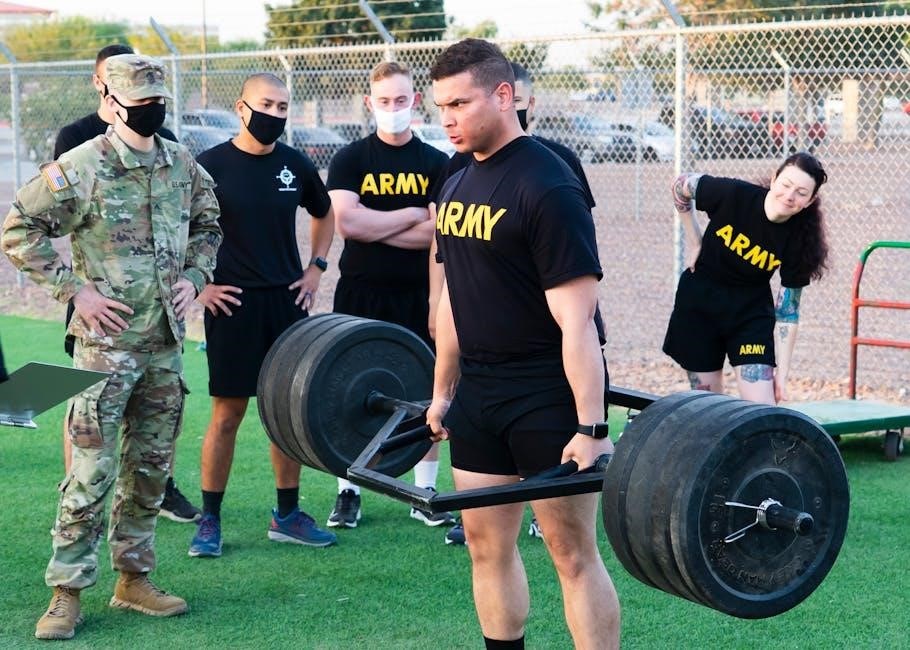MIL-STD-810F is a Department of Defense test method standard for environmental engineering, published on January 1, 2000. It ensures equipment durability under extreme conditions like temperature, humidity, vibration, and dust, critical for military applications.
Overview of MIL-STD-810F
MIL-STD-810F is a Department of Defense test method standard that establishes environmental engineering considerations and laboratory test procedures. It provides guidelines for testing military equipment to ensure reliability and durability under various environmental conditions. The standard includes tests for extreme temperatures, humidity, vibration, shock, dust, and other stresses. It is designed to simulate real-world operational conditions, helping to identify potential failures and ensuring equipment performance in harsh environments. MIL-STD-810F is widely used in military procurement and acquisition processes. It has been superseded by MIL-STD-810G but remains relevant for legacy systems. The standard emphasizes tailoring tests to specific equipment requirements, ensuring cost-effectiveness and relevance. It also includes detailed procedures for laboratory testing, making it a comprehensive resource for military and commercial applications. By adhering to MIL-STD-810F, manufacturers can ensure their products meet rigorous military standards, enhancing reliability and operational readiness.
Scope and Purpose of MIL-STD-810F
MIL-STD-810F provides environmental testing guidelines to ensure military equipment reliability under harsh conditions. It covers extreme temperatures, humidity, vibration, and dust, aiding in equipment design and procurement for operational readiness.
Importance of Environmental Testing in Military Standards
Environmental testing is critical for ensuring military equipment reliability and safety under harsh conditions. MIL-STD-810F ensures devices withstand extreme temperatures, humidity, vibration, and dust, crucial for mission success. This testing validates equipment durability, preventing field failures and protecting personnel. By simulating real-world scenarios, it guarantees operational readiness across diverse environments, from desert sands to Arctic cold. Standardization fosters consistency, enabling seamless integration across military branches and manufacturers.

Key Testing Methods in MIL-STD-810F
MIL-STD-810F includes tests for temperature, humidity, vibration, shock, and dust resistance. These methods ensure equipment reliability under extreme conditions, validating durability and performance in real-world military environments.
Environmental Stress Testing Procedures
MIL-STD-810F outlines detailed environmental stress testing procedures to evaluate equipment durability under various conditions. These include temperature extremes, humidity, vibration, shock, and exposure to dust. Tests are designed to simulate real-world environments, ensuring equipment reliability. Procedures involve controlled lab settings, where parameters like temperature cycling and humidity levels are precisely managed. Vibration and shock tests assess equipment resilience to mechanical stress, while dust testing evaluates performance in harsh, particulate-rich environments. Each test method is tailored to specific equipment requirements, ensuring relevance and accuracy. The standard emphasizes thorough documentation and repeat testing to validate results. These procedures are critical for military applications, where equipment must withstand extreme conditions. By following MIL-STD-810F, manufacturers ensure their products meet rigorous performance standards, guaranteeing reliability in the field. These tests are foundational for equipment qualification and acceptance in military and aerospace industries.
Tailoring Tests for Specific Equipment Requirements
MIL-STD-810F emphasizes the importance of tailoring tests to meet specific equipment requirements, ensuring relevance and efficiency. This approach allows manufacturers to adapt standard test methods to the unique needs of their equipment, considering factors like intended use, operating environments, and design specifications. The standard provides guidelines for tailoring, involving collaboration between manufacturers and military agencies to define test parameters. This customization ensures that equipment is tested under conditions that closely mirror real-world scenarios, enhancing reliability. Tailoring may involve modifying test durations, intensities, or sequences based on equipment-specific demands. For example, equipment designed for desert environments may undergo more rigorous dust and high-temperature testing. This flexibility ensures that tests are both comprehensive and cost-effective, avoiding unnecessary procedures. By tailoring tests, MIL-STD-810F promotes the development of robust, reliable equipment tailored to specific military applications, ensuring optimal performance in the field.
Laboratory Test Methods and Procedures
Laboratory Test Methods and Procedures
MIL-STD-810F outlines detailed laboratory test methods and procedures to evaluate equipment performance under various environmental stresses. These tests simulate real-world conditions, such as temperature extremes, humidity, vibration, and dust, to ensure equipment reliability. The standard provides specific protocols for each test, including setup, execution, and data collection. For instance, Method 510.4 specifies procedures for blowing dust testing, while Method 511.3 covers explosive atmosphere testing. Laboratories conducting these tests must adhere to strict guidelines to ensure consistency and accuracy. Equipment is subjected to controlled environmental stresses in specialized chambers, with precise monitoring of parameters like temperature, humidity, and vibration levels. Test reports document results, highlighting equipment strengths and weaknesses. By following these standardized procedures, manufacturers can ensure their products meet military requirements, fostering confidence in their performance under harsh conditions. This systematic approach ensures that laboratory testing is both rigorous and repeatable, providing reliable data for military procurement decisions.

Application and Use of MIL-STD-810F
MIL-STD-810F is widely used in military procurement to ensure equipment meets rigorous environmental standards. It guides the design, testing, and acquisition of systems, ensuring reliability in harsh operational conditions, from extreme temperatures to dust exposure.
Role in Military Equipment Procurement and Acquisition
MIL-STD-810F plays a pivotal role in military equipment procurement and acquisition by establishing standardized testing protocols. This ensures that equipment can withstand harsh environmental conditions encountered in operational scenarios, such as extreme temperatures, humidity, and vibration. By adhering to these standards, the Department of Defense (DoD) ensures that acquired systems are reliable and durable, reducing the risk of failure in the field. The standard also streamlines the procurement process by providing clear guidelines for manufacturers, allowing them to design and test equipment in compliance with military requirements. This consistency ensures that all equipment meets the necessary performance criteria, ultimately supporting national security objectives. MIL-STD-810F is integral to maintaining the readiness and effectiveness of military forces worldwide.

Updates and Revisions in MIL-STD-810F
MIL-STD-810F, published in January 2000, introduced significant updates to environmental testing standards, expanding the scope of conditions like temperature and vibration. It has since been succeeded by MIL-STD-810G, but remains relevant for historical reference. Download the PDF for detailed insights.
Significant Changes from Previous Versions (e.g., MIL-STD-810E)
MIL-STD-810F introduced substantial updates compared to its predecessor, MIL-STD-810E. Key changes included the expansion of environmental design and testing processes, ensuring broader applicability to military equipment. New test methods were added, such as Method 510.4 for blowing dust testing, while existing methods like shock and vibration procedures were refined for greater accuracy. The revision also emphasized tailored testing procedures, allowing customization based on specific equipment requirements. Additionally, MIL-STD-810F incorporated updated guidelines for laboratory testing, enhancing the standard’s ability to address diverse environmental challenges. These changes aimed to improve the durability and reliability of military equipment under extreme conditions. For detailed insights, download the MIL-STD-810F PDF.

Availability and Access to MIL-STD-810F
MIL-STD-810F is accessible as a downloadable PDF from official Department of Defense websites, such as Health.mil. The document, sized at 2043.12 Kbytes and spanning 16 pages, is available for public access.
Downloading the MIL-STD-810F PDF
The MIL-STD-810F document is readily available for download from official Department of Defense (DoD) websites, such as Health.mil. The PDF file, sized at 2043.12 Kbytes and consisting of 16 pages, provides detailed test methods and guidelines for environmental engineering considerations. Users can access the document directly from the official portals without requiring special permissions, ensuring widespread availability. Additionally, third-party websites may host the PDF, but it is strongly recommended to use official sources to ensure authenticity and avoid unauthorized modifications. The document is approved for use by all DoD departments and agencies, making it a crucial resource for military equipment testing. It is important to note that MIL-STD-810F has been superseded by MIL-STD-810G, but the older version remains accessible for reference purposes. Always verify the download source to ensure the file’s integrity and compliance with official standards.
MIL-STD-810F serves as a critical standard for evaluating the durability and reliability of military equipment under various environmental conditions. Its comprehensive test methods ensure that equipment can withstand extreme temperatures, vibrations, humidity, and other stresses. By adhering to this standard, manufacturers can guarantee the performance and longevity of their products in real-world operational scenarios. While MIL-STD-810F has been succeeded by MIL-STD-810G, it remains a foundational document for understanding environmental testing practices. Its availability as a downloadable PDF from official sources ensures accessibility for stakeholders involved in military procurement and equipment development. This standard underscores the importance of rigorous testing to meet the demands of military operations, ensuring readiness and reliability in critical situations. Its legacy continues to influence modern testing protocols, reinforcing its significance in the field of defense and military engineering.
